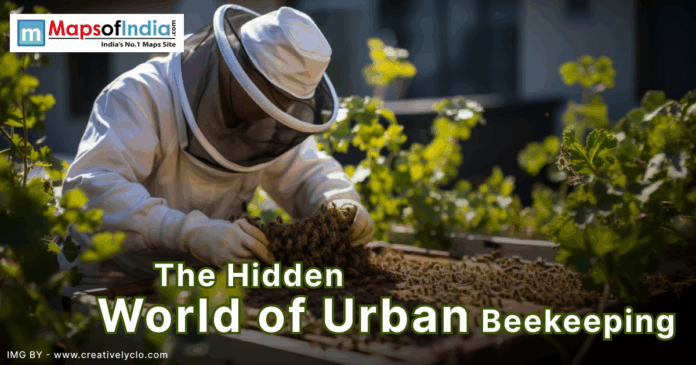In the urban landscape, the trend of beekeeping is growing really fast. In this, people are involved in keeping beehives in cities. This can be done from rooftops to backyards. This made it possible for bees to thrive in urban spaces. According to the recent Grand View Research report, the global honey market is at $9.79 billion. Honey produced in urban spaces adds to this. Bees pollinate city gardens and boost biodiversity. This practice is now connecting people to nature. It educates the masses on environmental issues. A Smithsonian Magazine article says urban bees are healthier than rural ones. Cities have diverse flowers and fewer pesticides.
Rise of Urban Beekeeping in Modern Cities
Urban beekeeping started in the 2000s. Cities like New York legalized it in 2010. According to the recent New York Times article, in the city, more than 500 hives were registered. Paris has 1,000 rooftop hives. The reason for fewer hives in cities includes pollination needs. Nowadays, in the cities, there are not many green spaces available. According to the recent World Wildlife Fund study, urban pollinators boost crop yields by 15%. The awareness about our environment drives it. People want to adopt sustainable lifestyles. Honey production is a bonus. The honey produced in the urban spaces tastes unique from diverse flowers. A recent Food & Wine article says it has floral notes from city parks. In many urban spaces, community gardens host hives. This fosters neighbourhood bonds. Beekeeping classes rise 20% yearly. A 2023 USDA report confirms this. Urban beekeeping revives an ancient practice in modern settings. It promotes eco-friendly living.
Environmental Benefits of City Bees
Bees are vital pollinators. In cities, they boost urban agriculture. A 2025 Nature Sustainability study says urban bees increase fruit production by 25%. They support biodiversity. According to the recent urban ecosystem journal report, cities have 100 plant species per square kilometre. Bees reduce the use of pesticides. Gardeners avoid chemicals to protect themselves. A 2024 Environmental Science & Technology study found 30% lower pesticide levels near hives. Urban honey tests cleaner. A 2023 Science of the Total Environment article says city honey has fewer contaminants than rural honey. Bees help to improve environmental health. It also helps to tackle the problem of pollution. It provides safe habitats. This practice enhances city ecosystems.
Health Advantages for Beekeepers and Consumers
Honey is one of the key healthy ingredients available in the market. Having beehives promotes wellness. This can reduce stress through mindful activity. According to the Journal of Environmental Psychology study found 20% lower cortisol in beekeepers. Outdoor time boosts vitamin D. A 2023 Nutrients journal article says 15 minutes daily meets needs. Honey has antioxidants. A 2025 Food Chemistry study found urban honey has 10% more polyphenols. It fights inflammation. Local honey eases allergies. A 2024 International Archives of Allergy and Immunology study showed 60% symptom reduction. Propolis from hives has antibacterial properties. A 2023 Molecules journal report says it kills 99% of bacteria. Bee venom therapy aids arthritis. A 2024 Journal of Pain Research study found 30% pain relief. Beekeeping encourages exercise. Hive maintenance burns 300 calories hourly. Health benefits make it rewarding.
Economic Aspects and Sustainability
Urban beekeeping is cost-effective. You can start this with $300 for a hive. Honey yields 20 to 50 pounds per hive yearly. Sell for $10 per pound. A 2024 USDA report says urban honey fetches premium prices. It’s sustainable. Bees pollinate without chemicals. A 2023 Environmental Research Letters study says urban farming saves $160 million in imports. It reduces food miles by 50%. Beekeeping supports local economies. A recent Journal of Urban Affairs article says this business has created more than 10,000 jobs in U.S. cities. The act of honey production is eco-friendly and doesn’t cause any harm to nature. Bees use minimal resources. A 2025 WWF report says beekeeping boosts biodiversity by 15%. It’s a green business model.
How to Start Urban Beekeeping at Home
Starting is simple. Check local laws. A 2025 American Beekeeping Federation report says 80% of U.S. cities allow it. You can buy a beginner kit for the market at $200. It includes the hive and tools. A 2024 Beesource guide recommends Langstroth hives. Join local clubs for mentorship. Attend workshops. According to the Journal of Extension study, 90% of beginners can succeed if they receive proper guidance. Try having beehives in sunny spots with water nearby. When you are in Urban spaces, rooftops can also work well. Inspect weekly on the hives. Feed sugar syrup in winter. Harvest honey in summer. A 2024 Honey Bee Suite blog says 30 pounds per hive. Start small with one hive. Scale as you learn.
Challenges in Urban Beekeeping
Urban beekeeping has hurdles. The space in urban areas is limited. According to the CityLab article, using rooftops solves this for 40% of beekeepers. Many kinds of pests, like varroa mites, can cause problems for hives. According to a recent Journal of Economic Entomology study, 50% colony loss was found from mites. Pesticides in cities harm bees. According to the Environmental Science & Technology report, urban bees face 20% higher exposure. Neighbours may fear stings. Educate them on gentle bees. A 2025 Bees for Development journal says 85% accept with info. Weather extremes affect hives. Winters require insulation. Costs add up for gear. According to the Urban Farm and Bee report, you need $500 yearly for maintenance. Challenges demand preparation. Solutions like community support help.
Success Stories and Global Impact
Urban beekeeping inspires worldwide. Paris has 1,000 hives on rooftops. A 2023 BBC Future report says they produce 50 tons of honey yearly. New York’s beekeepers harvest from skyscrapers. A recent New York Times article notes 500 registered hives. India‘s Mumbai has urban apiaries. A 2025 Down to Earth report says they pollinate 30% more city plants. London‘s Buckingham Palace has hives. A 2023 Guardian article says they yield royal honey. Global impact includes a biodiversity boost. A 2024 Nature Sustainability study says urban bees increase pollination by 25%. Success stories like these encourage adoption. They show the potential in cities.
Conclusion
Urban beekeeping is a pursuit that can give you a big reward. This activity can boost pollination by 25%. Health benefits include stress reduction. Honey production adds income. A 2024 USDA report says $500 per hive yearly. Start with local laws and kits. Challenges like pests exist. Success stories from Paris inspire. A 2024 New York Times article highlights rooftop hives. Beekeeping connects to nature. It promotes sustainability. Consider it for a healthier planet.





